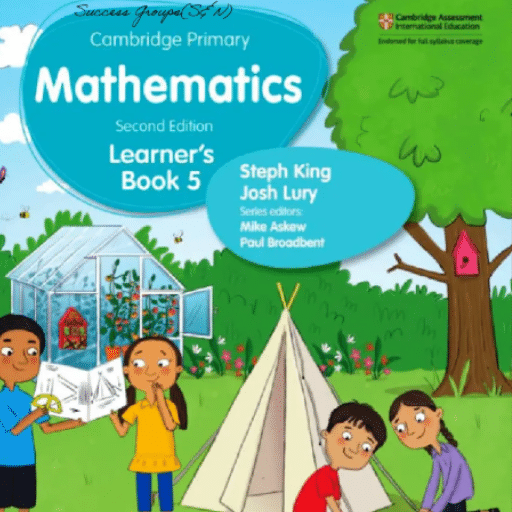
|
PARTNER COURSE
Year 5 Primary Mathematics (Cambridge) for Class 55,738 students learning this week · Last updated on Oct 09, 2025 |
Year 5 Primary Mathematics (Cambridge) Study Material
Trending Courses for Class 5
Year 5 Mathematics IGCSE (Cambridge) for Class 5 CBSE Exam Pattern 2025-2026
Year 5 Primary Mathematics (Cambridge) Exam Pattern for Year 5
The Year 5 Primary Mathematics exam under the Cambridge curriculum is designed to assess students' understanding and application of mathematical concepts. Understanding the exam pattern is crucial for effective preparation. Below are the key components of the exam structure:
1. Exam Structure
- Format: The exam typically consists of multiple-choice questions, short-answer questions, and problem-solving tasks.
- Duration: The total time allocated for the exam is usually around 1.5 to 2 hours.
- Sections: The exam is divided into different sections, focusing on various areas of mathematics.
2. Key Areas of Assessment
- Number and Place Value: Understanding of numbers, place value, and the ability to perform operations with whole numbers.
- Fractions, Decimals, and Percentages: Knowledge of fractions, their equivalents, as well as decimal and percentage conversions.
- Measurement: Skills in measuring length, weight, volume, and time, including conversions between units.
- Geometry: Understanding of shapes, angles, symmetry, and basic properties of 2D and 3D figures.
- Data Handling: Ability to interpret and represent data using charts, graphs, and tables.
- Algebra: Introduction to basic algebra concepts, including simple equations and patterns.
3. Scoring and Grading
- Marking Scheme: Each section has a specific number of marks allocated, contributing to the overall score.
- Grade Boundaries: The performance is graded typically on a scale from A to E, with A being the highest.
- Feedback: Students receive feedback on their performance, highlighting strengths and areas for improvement.
4. Preparation Tips
- Practice Regularly: Engage in regular practice using sample papers and past exam questions.
- Understand Concepts: Focus on understanding mathematical concepts rather than rote memorization.
- Time Management: Develop effective time management skills to complete the exam within the allotted time.
- Use Resources: Utilize high-quality study materials and resources available on platforms like EduRev for comprehensive preparation.
In conclusion, understanding the Year 5 Primary Mathematics exam pattern is essential for effective preparation. Students should focus on mastering the key areas of assessment and practice regularly to build confidence and achieve success in their exams.
Year 5 Mathematics IGCSE (Cambridge) Syllabus 2025-2026 PDF Download
Year 5 Primary Mathematics (Cambridge) Syllabus
The Year 5 Primary Mathematics syllabus is designed to develop a strong foundation in mathematical concepts and skills. This syllabus encompasses a variety of topics, ensuring that students gain a comprehensive understanding of mathematics. Below is a detailed breakdown of the Year 5 syllabus.
Year 5 The Number System
- Understanding whole numbers, place value, and number lines.
- Recognizing and working with negative numbers.
- Introduction to prime and composite numbers.
Year 5 2D Shape and Pattern
- Identifying and classifying 2D shapes (triangles, quadrilaterals, circles).
- Exploring symmetry and patterns in shapes.
- Creating and extending patterns using 2D shapes.
Year 5 Numbers and Sequences
- Understanding number sequences and identifying patterns.
- Working with odd and even numbers.
- Exploring arithmetic sequences.
Year 5 Averages
- Calculating the mean, median, and mode of a set of numbers.
- Understanding the concept of range in data sets.
Year 5 Addition and Subtraction
- Using mental strategies for addition and subtraction.
- Solving multi-digit addition and subtraction problems.
- Understanding and applying the concept of regrouping.
Year 5 3D Shapes
- Identifying and classifying 3D shapes (cubes, spheres, pyramids).
- Exploring the properties of 3D shapes.
- Understanding volume and surface area concepts.
Year 5 Fractions, Decimals and Percentages
- Understanding fractions and their equivalent forms.
- Converting between fractions, decimals, and percentages.
- Solving problems involving fractions, decimals, and percentages.
Year 5 Probability
- Understanding the concept of probability and chance.
- Using probability scales to represent likelihood.
- Conducting simple probability experiments.
Year 5 Addition and Subtraction of Fractions
- Adding and subtracting fractions with like denominators.
- Finding common denominators for unlike fractions.
- Solving word problems involving fraction addition and subtraction.
Year 5 Angles
- Identifying different types of angles (acute, obtuse, right).
- Measuring angles using a protractor.
- Understanding complementary and supplementary angles.
Year 5 Multiplications and Division
- Understanding multiplication facts and tables.
- Applying long division and short division methods.
- Solving word problems involving multiplication and division.
Year 5 Data
- Collecting, organizing, and presenting data using charts and graphs.
- Interpreting data and drawing conclusions.
- Understanding the importance of data representation.
Year 5 Ratio and Proportion
- Understanding the concept of ratio and proportion.
- Solving problems involving ratios in real-life contexts.
- Identifying equivalent ratios.
Year 5 Area and Perimeter
- Calculating the area and perimeter of various shapes.
- Understanding the relationship between area and perimeter.
- Solving real-world problems involving area and perimeter.
Year 5 Multiplying and Dividing Fractions and Decimals
- Multiplying and dividing fractions with whole numbers.
- Understanding the rules for multiplying and dividing decimals.
- Solving problems involving fractional and decimal calculations.
Year 5 Time
- Understanding time concepts (hours, minutes, seconds).
- Reading and interpreting clocks and calendars.
- Calculating elapsed time and scheduling events.
Year 5 Number and The Laws of Arithmetic
- Understanding the properties of operations (associative, commutative).
- Applying the order of operations in calculations.
- Using arithmetic to solve real-life problems.
Year 5 Position and Direction
- Understanding coordinates and grid systems.
- Identifying and describing positions using direction and movement.
- Exploring transformations (translations, rotations, reflections).
This comprehensive Year 5 Primary Mathematics syllabus ensures that students are well-equipped with essential mathematical skills, preparing them for future academic challenges. Each topic is designed to engage students and enhance their understanding of mathematics in everyday life.
This course is helpful for the following exams: Class 5
How to Prepare Year 5 Mathematics IGCSE (Cambridge) for Class 5?
How to Prepare Year 5 Primary Mathematics (Cambridge) for Year 5?
Preparing for Year 5 Primary Mathematics (Cambridge) involves a combination of understanding the curriculum, practicing key concepts, and developing problem-solving skills. Here are effective strategies to help students excel in this course offered by EduRev:
1. Understand the Curriculum
- Familiarize yourself with the Year 5 Primary Mathematics (Cambridge) curriculum objectives.
- Identify key topics such as numbers, geometry, measurement, and data handling.
2. Create a Study Schedule
- Allocate specific times for studying Year 5 Primary Mathematics (Cambridge) concepts.
- Ensure that the study schedule includes regular reviews and practice sessions.
3. Utilize Practice Resources
- Use worksheets and practice tests specifically designed for Year 5 Primary Mathematics (Cambridge).
- Engage with interactive activities and games that reinforce mathematical skills.
4. Focus on Problem-Solving Skills
- Encourage critical thinking by solving word problems related to Year 5 Primary Mathematics (Cambridge).
- Teach different strategies for tackling complex problems, such as drawing diagrams or breaking down tasks.
5. Encourage Group Study
- Form study groups with peers to discuss Year 5 Primary Mathematics (Cambridge) topics.
- Collaborate on challenging exercises to enhance understanding through discussion.
6. Seek Help When Needed
- Do not hesitate to ask teachers or tutors for clarification on difficult concepts in Year 5 Primary Mathematics (Cambridge).
- Utilize EduRev resources for additional explanations and guidance.
7. Monitor Progress
- Regularly assess your understanding of Year 5 Primary Mathematics (Cambridge) through quizzes and self-tests.
- Reflect on areas of improvement and adjust study methods accordingly.
Conclusion
By following these strategies, students can confidently prepare for Year 5 Primary Mathematics (Cambridge) and enhance their mathematical abilities. Consistent practice and engagement with the material will lead to success in the course offered by EduRev.
Importance of Year 5 Mathematics IGCSE (Cambridge) for Class 5
Importance of Year 5 Primary Mathematics (Cambridge) Course for Year 5
The Year 5 Primary Mathematics (Cambridge) Course offered by EduRev plays a crucial role in the educational journey of students. This course not only aligns with international standards but also lays a strong foundation for future mathematical learning. Below are some key reasons highlighting its importance:
1. Enhanced Understanding of Mathematical Concepts
- The course covers essential mathematical concepts such as addition, subtraction, multiplication, and division.
- Students engage with real-world problems, fostering a deeper understanding of how mathematics applies to everyday life.
2. Development of Critical Thinking Skills
- By tackling challenging problems, students enhance their critical thinking and problem-solving skills.
- The curriculum encourages analytical thinking, which is vital for academic success and everyday decision-making.
3. Preparation for Future Learning
- The Year 5 course sets the stage for more advanced mathematical topics in subsequent years.
- A strong foundation in Year 5 ensures students are well-prepared for the complexities of secondary mathematics.
4. Interactive Learning Experience
- EduRev’s course incorporates interactive elements that make learning engaging and enjoyable.
- Visual aids and practical activities help reinforce concepts, catering to different learning styles.
5. Assessment and Feedback
- Regular assessments provide students with immediate feedback on their progress.
- This helps identify areas for improvement and ensures that students stay on track with their learning goals.
6. Boosting Confidence in Mathematics
- As students master new concepts, they gain confidence in their mathematical abilities.
- Increased confidence can lead to a more positive attitude towards learning and a greater willingness to tackle challenges.
7. Support for Diverse Learning Needs
- The course is designed to cater to a wide range of learning abilities, ensuring that every student can thrive.
- Individualized learning paths allow students to progress at their own pace, ensuring mastery of each topic.
Conclusion
The Year 5 Primary Mathematics (Cambridge) Course by EduRev is essential for young learners. It not only equips them with important mathematical skills but also prepares them for future academic challenges. By fostering a love for mathematics and enhancing critical thinking abilities, this course lays the groundwork for lifelong learning and success.
Year 5 Mathematics IGCSE (Cambridge) for Class 5 FAQs
| 1. What topics are covered in Year 5 Primary Mathematics according to the Cambridge curriculum? |  |
| 2. How can I prepare for the Year 5 Primary Mathematics exam? |  |
| 3. What types of questions can I expect in the Year 5 Primary Mathematics exam? |  |
| 4. Are calculators allowed in the Year 5 Primary Mathematics exam? |  |
| 5. How important is understanding fractions in Year 5 Mathematics? |  |
| 6. What are some effective strategies for solving word problems in mathematics? |  |
| 7. How can I improve my mental math skills for Year 5 Mathematics? |  |
| 8. What role does geometry play in the Year 5 Mathematics curriculum? |  |
| 9. How can I help my child with Year 5 Mathematics at home? |  |
| 10. How is data handling taught in Year 5 Mathematics? |  |
| 11. What are common mistakes students make in Year 5 Mathematics? |  |
| 12. How can I track my progress in Year 5 Mathematics? |  |
| 13. What is the importance of learning decimals in Year 5 Mathematics? |  |
| 14. How do I tackle challenging math problems in Year 5? |  |
| 15. What resources are available for Year 5 Mathematics revision? |  |
Best Coaching for Year 5 Mathematics IGCSE (Cambridge) for Class 5
Tags related with Year 5 Mathematics IGCSE (Cambridge) for Class 5
Best Year 5 Mathematics IGCSE (Cambridge) for Class 5 NCERT Solutions and Study Materials

|
View your Course Analysis |

|

|
Create your own Test |

|


































